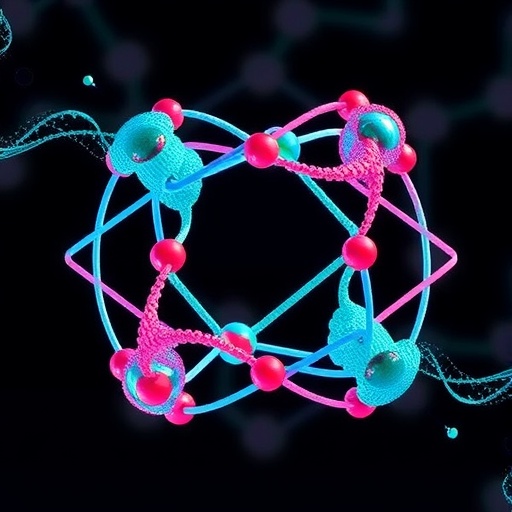In a groundbreaking advancement at the nexus of geometry and quantum physics, researchers have unveiled a pioneering experimental realization of topological pumping within hyperbolic lattices, marking the first instance where two-dimensional physical systems emulate the complex behaviors traditionally relegated to eight-dimensional spaces. This novel work transcends conventional dimensional limits by harnessing the unique curvature properties inherent in hyperbolic geometry, opening unprecedented avenues toward high-dimensional quantum simulations and resilient topological devices.
The team constructed what is known as a hyperbolic {8,8} lattice—a two-dimensional structure characterized by constant negative curvature—distinctively differentiating it from the flat geometry of Euclidean lattices. This choice of lattice is not arbitrary; the hyperbolic architecture endows the system with an expanded set of geometric and topological features that can, in principle, encode information equivalent to phenomena occurring in far higher-dimensional quantum systems. By embedding appropriately tailored electromagnetic fields within this lattice, the researchers devised the first-ever topological pumping framework in non-Euclidean space, effectively mapping complex quantum Hall physics into a feasible experimental realm.
Underpinning this achievement is the theoretical confirmation that the ground-state energy band of the hyperbolic lattice carries topological invariants mirroring those of the eight-dimensional quantum Hall effect (QHE). The quantum Hall effect, first observed in two-dimensional electron systems, reveals quantized conductance governed by topological invariants known as Chern numbers. Extending such physics to higher-dimensional analogues has been largely mathematical or theoretical until now, due to the formidable challenge of realizing physical systems with more than three spatial dimensions. Remarkably, the hyperbolic lattice circumvents these restrictions by leveraging intrinsic curvature to emulate the higher-dimensional topological environment within a physically two-dimensional platform.
Crucially, the researchers demonstrated that when this hyperbolic system is adiabatically modulated—that is, slowly and continuously altered over time—it exhibits quantized transport of wavepackets with velocities precisely aligned with theoretical predictions for eight-dimensional quantum Hall states. This quantization reflects a discrete, topologically protected nature of particle motion, resistant to imperfection or disorder, thus confirming the system’s capacity to simulate high-dimensional topological pumping phenomena experimentally.
An intriguing and unprecedented aspect of the study lies in the sensitivity of transport behaviors to the system’s periodic boundary conditions (PBCs). Unlike Euclidean lattices, where boundary conditions typically exert limited control over bulk transport phenomena, the unique non-Abelian structure of the hyperbolic translation groups induces fundamentally new transport regimes. Under one class of PBCs, wavepackets execute quantum jumps between discrete unit cells in a seemingly discontinuous fashion. Alternatively, a different PBC configuration prompts these wavepackets to undergo periodic topological oscillations, whereby after each pump cycle, they return exactly to their starting positions. This ability to toggle between distinct transport behaviors via boundary conditions alone represents a form of dynamical topological control heretofore unseen.
This sensitivity arises from the intricate topology of hyperbolic space, wherein the translation symmetries do not commute—unlike in ordinary Euclidean space—introducing a rich algebraic structure that governs particle dynamics. As co-senior author Weixuan Zhang noted, this non-Abelian nature of hyperbolic translation groups formulates transport rules that fundamentally depart from what conventional Euclidean materials can offer, broadening the horizon for engineering novel quantum phases and devices.
To substantiate these theoretical insights, the team engineered a sophisticated electronic circuit network comprising 512 nodes meticulously designed to emulate the connectivity and dynamics of the hyperbolic lattice. By measuring voltage responses within this network, they were able to experimentally observe trajectories akin to those predicted for six-dimensional quantum Hall systems, confirming not only the high-dimensional quantum Hall signatures but also the boundary-dependent topological pumping and oscillation effects. This marks the inaugural experimental observation of topological pumping within a hyperbolic geometry framework.
The implications of this study are extensive and multifaceted. By demonstrating that the effective dimensionality governing topological phenomena can be augmented through geometric engineering rather than physical spatial embedding, this research fundamentally changes the landscape of quantum simulation. It suggests that complex high-dimensional quantum phenomena may be accessible and controllable within practically realizable two-dimensional architectures, facilitating the design of quantum devices with enhanced functionality and robustness.
Moreover, the unique manipulation of quantum transport via boundary conditions introduces versatile control knobs for future quantum technologies. The capacity to induce topological oscillations and quantum jumps through boundary engineering could be harnessed to develop resilient quantum memory, topologically protected quantum gates, or error-correcting schemes essential for scalable quantum computing.
This breakthrough also ushers in new theoretical challenges and opportunities. The interplay of hyperbolic geometry, topology, and non-Abelian symmetries invites deeper exploration of exotic quantum phases and transitions. It raises questions about the full classification of topological invariants in curved spaces and the potential for realizing even higher “synthetic” dimensions through more intricate geometric configurations.
Supported by the National Key Research and Development Program of China and the National Natural Science Foundation of China, this research crystallizes a path toward leveraging non-Euclidean geometries to unlock novel quantum phenomena. As co-senior author Xiangdong Zhang emphasized, the ability to transcend dimensional constraints implies that physical systems are not confined by their apparent spatial layout but can emulate the complex quantum behaviors previously thought exclusive to abstract higher-dimensional frameworks.
In conclusion, the advent of topological pumping in hyperbolic lattices not only challenges foundational understandings of dimension and geometry in quantum physics but also catalyzes the development of new quantum simulation platforms and fault-tolerant devices. By swiftly advancing from conceptual theory to experimental realization, this work exemplifies the power of interdisciplinary approaches, blending geometry, topology, and electronic engineering to break frontiers at the heart of quantum science.
Subject of Research: Quantum Hall effect and topological pumping in hyperbolic lattices
Article Title: Anomalous topological pumping in hyperbolic lattices
Web References: http://dx.doi.org/10.1016/j.scib.2025.07.040
Image Credits: ©Science China Press
Keywords: Hyperbolic lattice, topological pumping, quantum Hall effect, high-dimensional quantum simulation, non-Euclidean geometry, periodic boundary conditions, non-Abelian symmetries, electronic circuit emulation, topological transport, synthetic dimensions




